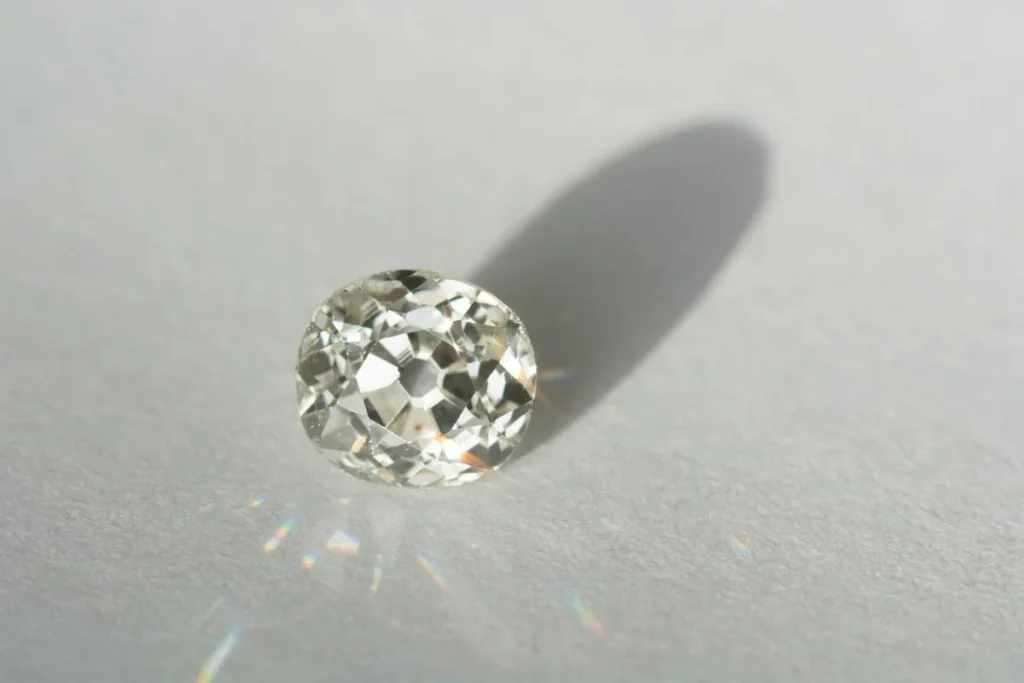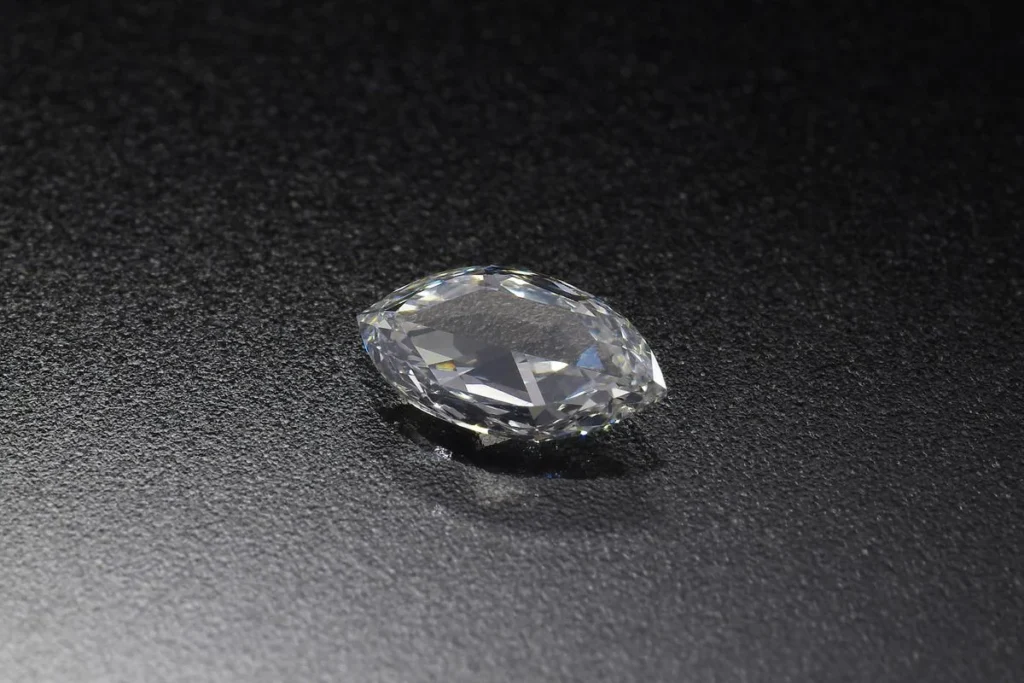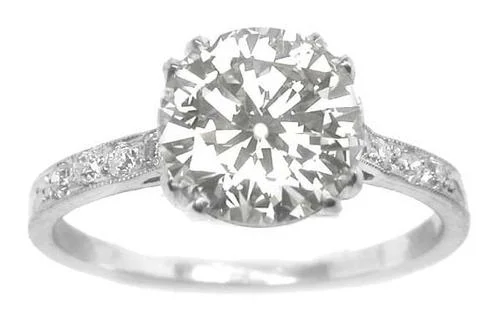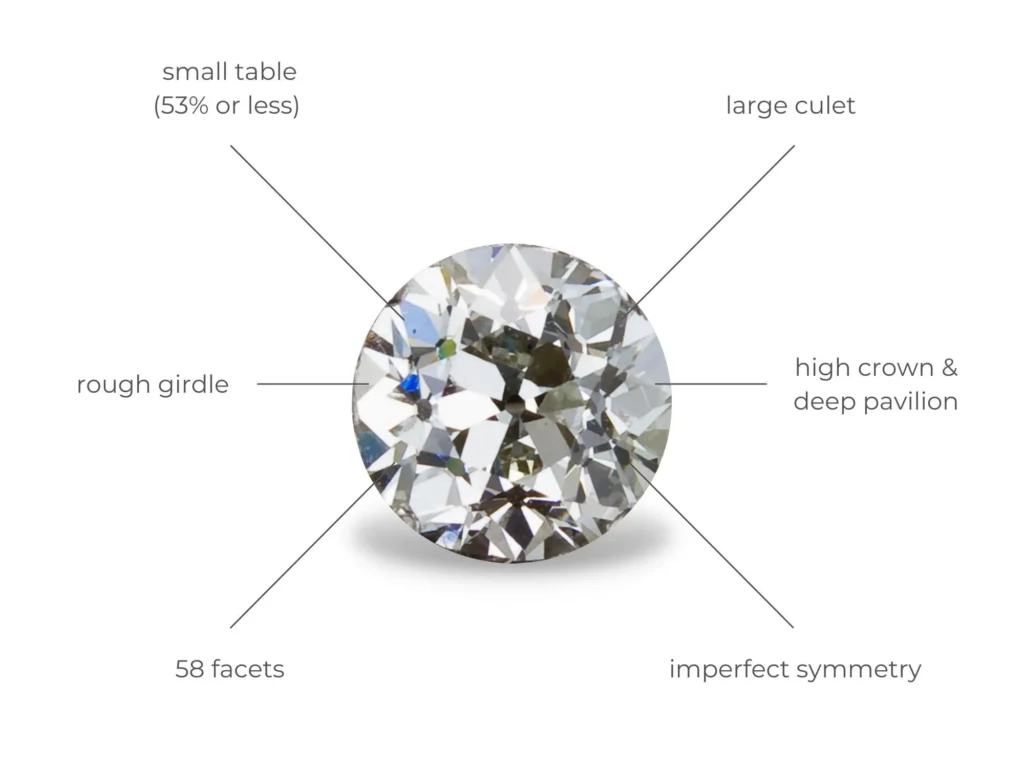Introduction

Old-cut diamonds, also known as antique or vintage diamonds
They are renowned for their timeless beauty due to their unique characteristics, historical significance, and distinct aesthetic.
These diamonds were crafted using techniques popular during the 18th and 19th centuries, offering a sense of history and romance.
They come in various antique cuts, such as the Old Mine Cut, the Old European Cut, and the Rose Cut, with different facets and proportions compared to modern cuts.
These diamonds also have a warmer color and a subtle, romantic glow due to their deeper pavilion and larger facets.
They exhibit a captivating play of light known as scintillation, which adds to their charm and allure.
As they avoid the environmental impact of mining new stones and support the idea of repurposing and recycling.
As time goes on, there are fewer old-cut diamonds available today, making them more exclusive and valuable.
The purpose and scope of old cut diamonds are multifaceted, encompassing historical significance, aesthetic appeal, sentimental value, customization and repurposing, investment, and artistic inspiration.
They offer a unique blend of aesthetics and significance that appeals to a diverse range of individuals, making them a cherished and enduring choice in the world of fine jewelry.
History of Old Cut Diamonds
The history of diamond-cutting techniques spans centuries and reflects the evolution of diamond-cutting craftsmanship.
Key stages include the Rose Cut (16th century), Table Cut (17th century), Old Mine Cut (18th century), Old European Cut (late 19th century), Point Cut (17th–18th century), and Briolette Cut (17th–18th century).
The evolution of early diamond cutting techniques laid the foundation for modern diamond cutting, which is the most popular and brilliant diamond cut today.
However, the charm and historical significance of early diamond cuts like the Rose Cut, Old Mine Cut, and Old European Cut continue to captivate connoisseurs of antique and vintage jewelry.
Old mine-cut diamonds hold a unique place in the world of gemstones and jewelry, offering insights into the historical, cultural, and technological aspects of diamond cutting during the 18th and 19th centuries.
They have a distinctive appearance, a connection to royalty and aristocracy, romantic and sentimental value, historical context, collectibility and rarity, and ethical and sustainable appeal.
The Round Brilliant Cut, a revolutionary and enduring diamond cut, has become the benchmark for maximizing a diamond’s brilliance and sparkle.
This transition marked a significant departure from old diamond-cutting techniques and ushered in a new era by focusing on scientific precision, optimal facets, standardization, brilliance and fire, popularity, and timeless appeal.
In conclusion, the history of diamond-cutting techniques spans centuries and continues to captivate connoisseurs of antique and vintage jewelry.
The Round Brilliant Cut, with its scientific precision, optimal facets, standardization, and balance of brilliance and fire, remains a timeless choice for those who appreciate the charm of the past in their jewelry.
What is Old Cut Diamonds?
An old-cut diamond, also known as an antique or vintage diamond, was cut and shaped using techniques popular during the 18th and 19th centuries.
These diamonds have distinctive characteristics such as a cushion shape, warmer colors, and inclusions or imperfections.
The cushion shape was popular during this era, and many fall in the near-colorless to faint yellow range.
The unique appeal of old-cut diamonds lies in their historical significance, distinctive appearance, and warmth and character they bring to jewelry.
They continue to captivate those who appreciate the vintage aesthetic and sense of history.
Types of Old Cut Diamonds
Rose Cut Diamonds
Originating in India, they were popular during the 16th to 18th centuries
The diamonds have a flat base with a domed top, featuring triangular facets.
They offer a gentler, subtle play of light, creating a warm and intimate ambiance
They are often associated with antique and vintage jewelry.

Rose-cut diamonds are versatile, used in various types of jewelry, and considered a symbol of elegance and sophistication.
Recently, there has been a resurgence of interest in rose-cut diamonds, as more people seek unique and vintage-inspired jewelry.
Old Mine Cut Diamonds

Old-mine cut diamonds, originating from India and Brazil, are a symbol of the romantic past.
They date back to the 18th and early 19th centuries, showcasing their unique cushion shape and faceted facets.
These diamonds often used in engagement rings and jewelry pieces to symbolize love and commitment.
Skilled artisans handcrafted them, shaping and polishing them meticulously to preserve their carat weight. Their sentimental value adds to their allure.
Many are passed down through generations as family heirlooms, showcasing the love stories of those who wore them.
Some choose to repurpose old mine-cut diamonds for ethical reasons, aligning with sustainability and responsible sourcing.
It is an expression of timeless elegance and a tribute to the enduring power of love and romance.
European Cut Diamonds
European Cut diamonds, popular in the late 19th century, marked a significant shift towards modern brilliance in diamond cutting.
They incorporated a symmetrical facet arrangement and improved brilliance, achieving a better balance between warmth and fire.

The European Cut was a pivotal step in the evolution towards the modern Round Brilliant Cut, refining cutting techniques and optics.
Its versatility in various jewelry types, including engagement rings and pendants, made it appealing to a broader consumer base.
European Cut diamonds are highly sought after for their vintage charm and historical significance.
Their principles laid the groundwork for the modern Round Brilliant Cut, which remains the most popular and widely recognized diamond cut today.
Characteristics
- The facet arrangement and unique symmetry of a diamond are crucial factors in its overall beauty, brilliance, and visual appeal.
- The table facet at the top of the diamond serves as a window into the diamond’s interior, creating reflections and refractions.
- Crown facets below the table capture incoming light, refract it, and disperse it into the visible spectrum, creating brilliance and sparkle.
- The girdle is the widest part of the diamond and marks the boundary between the top (crown) and bottom (pavilion) portions.
- Pavilion facets are strategically placed to refract light as it travels through the diamond, enhancing its brilliance.
- The culet, located at the very bottom of the diamond, prevents chipping at the diamond’s tip and helps direct light back toward the viewer when it escapes through the pavilion.
- Symmetry is essential for maximizing a diamond’s beauty, ensuring that light reflects and refracts consistently, resulting in optimal brilliance and scintillation.
- Diamonds are typically graded for symmetry, which can significantly affect a diamond’s value. Well-cut diamonds with precise symmetry appear more balanced and pleasing to the eye.
- The culet and crown are two distinctive features of a diamond that play crucial roles in its appearance, brilliance, and overall aesthetics.
- The culet protects the diamond’s tip from chipping or damage, while the crown plays a critical role in capturing, reflecting, and refracting incoming light.
- Old-cut diamonds offer a distinct and romantic light performance that sets them apart from modern cuts.
- They are characterized by large, chunky facets, a deep pavilion and high crown, warm and subtle brilliance, distinctive light dispersion, and a unique “fire” effect.
Old Cut Diamonds vs. Modern Cuts
Old Cut Diamonds
- Historical Charm: Exude a vintage and historical charm, reflecting the craftsmanship of the 18th and 19th centuries.
- Distinctive Appearance: Feature a cushion shape with large, chunky facets, creating a warm and romantic glow.
- Subtle Brilliance: Emit a gentle and warm brilliance with soft flashes of light, appealing to those who prefer a more subdued sparkle.
- Sentimental Value: Often passed down as family heirlooms, carrying stories and memories from generations past.
- Ethical Appeal: Repurposing existing diamonds aligns with ethical sourcing and sustainability values.
- Customizable: Can be set in modern or vintage-style settings for a unique and personalized look.
Modern Cut Diamonds
- Contemporary Brilliance: Exhibit intense brilliance and fire with precise mathematical proportions and advanced cutting techniques.
- Round Brilliant Cut: The iconic cut with 57 or 58 facets, renowned for its balanced brilliance and fire.
- Versatility: Available in various shapes, offering flexibility in design and style.
- Scientific Precision: Engineered for maximum light performance, reflecting the latest scientific understanding of diamond optics.
- Global Popularity: The preferred choice for engagement rings and fine jewelry worldwide.
- Dazzling Scintillation: Display dynamic scintillation with flashes and sparkles that captivate the eye.
- Ideal for Modern Aesthetics: Perfect for those who appreciate contemporary and sleek jewelry designs.
How To Care For Old Cut Diamond
Old-cut diamonds are valuable and valuable antique gemstones that require special care to maintain their beauty and longevity. To care for these diamonds, follow these guidelines:
Regular cleaning– Use a mild, non-abrasive cleaning solution or a mixture of warm water and dish soap to remove dirt, oils, and everyday grime.
Soak the diamond in the solution for 20-30 minutes, then gently scrub it with a soft-bristle toothbrush to remove residue. Rinse thoroughly with clean water.
Gentle handling- Avoid bumping or knocking the diamond against hard surfaces to prevent chipping or scratching. Store the jewelry separately in a fabric-lined box or soft pouch to prevent scratches.
Regular inspections– Schedule regular check-ups with a reputable jeweler to professionally clean and inspect the jewelry for any issues.
Avoid using harsh chemicals or engaging in activities that expose the diamond to chemicals, as they can dull its luster and affect its brilliance over time.
Professional maintenance– Schedule regular check-ups with a reputable jeweler to professionally clean and inspect the jewelry. Avoid unnecessary repolishing or recutting of the diamond, as it can alter its vintage characteristics and reduce its historical value.
Insure your old cut diamond jewelry– Consider insuring it to protect it from loss, theft, or damage. Avoid extreme temperatures, as they can stress the metal settings of the jewelry.
How To Choose Old Cut Diamond
To find reputable dealers and jewelers for old-cut diamonds, conduct thorough online research, choose accredited dealers and jewelers, visit physical stores, and prioritize transparency and education.
- Select the right old cut diamond for your style by understanding your personal preferences, choosing a diamond shape that resonates with your style, deciding between brilliance and warmth, setting and metal, budget, certification, and history.
- Set a realistic budget and understand the factors affecting pricing, such as carat weight, cut quality, color, clarity, and historical significance.
- Compare prices with multiple reputable dealers and jewelers to identify fair pricing.
- Request certification documents from independent gemological laboratories like the Gemological Institute of America (GIA) and ensure they match the diamond’s characteristics.
- Certification documents are crucial when buying old-cut diamonds, providing an independent assessment of the diamond’s characteristics.
- Look for old-cut diamonds with certifications from reputable labs like the GIA, AGS, IGI, or EGL USA.
- Review the certification document, ask for historical documentation, and store the documentation securely.
- Consider insurance considerations based on the information provided in the certification to protect your investment in case of loss, theft, or damage.
- By understanding budget considerations, negotiating prices thoughtfully, and prioritizing certification and documentation, you can make a well-informed and secure purchase of an old-cut diamond while preserving its authenticity and historical value.
Conclusion
Old-cut diamonds are timeless relics of artistry, craftsmanship, and history, dating back to the Georgian and Victorian eras.
These antique gems are known for their distinctive shapes, large facets, and warm brilliance, evoked by their soft flashes and captivating scintillation.
To select an Old Cut Diamond, research reputable dealers and jewelers with a history of transparency and customer satisfaction.
Meanwhile, understand your style preferences, set a realistic budget, prioritize proper care and maintenance, and appreciate the historical significance and sentimental value of these gems.
They are gateways to the past, capturing the essence of a romantic and artistic era. They embody the enduring power of love and craftsmanship, transcending time and trends.
Frequently Asked Questions (FAQ’s)
In terms of budget, Old Mine Cut diamonds can vary widely in price, depending on factors like size, quality, and rarity.
Old cut diamonds, especially in larger carat weights, are becoming increasingly rare.
The term refers to antique diamonds cut without the precision of modern cut diamonds. Other descriptions include ‘Old Mine Cut’ and ‘Victorian Cut.
Old mine diamonds were cut for candlelight which makes them sparkle in even dim light.
